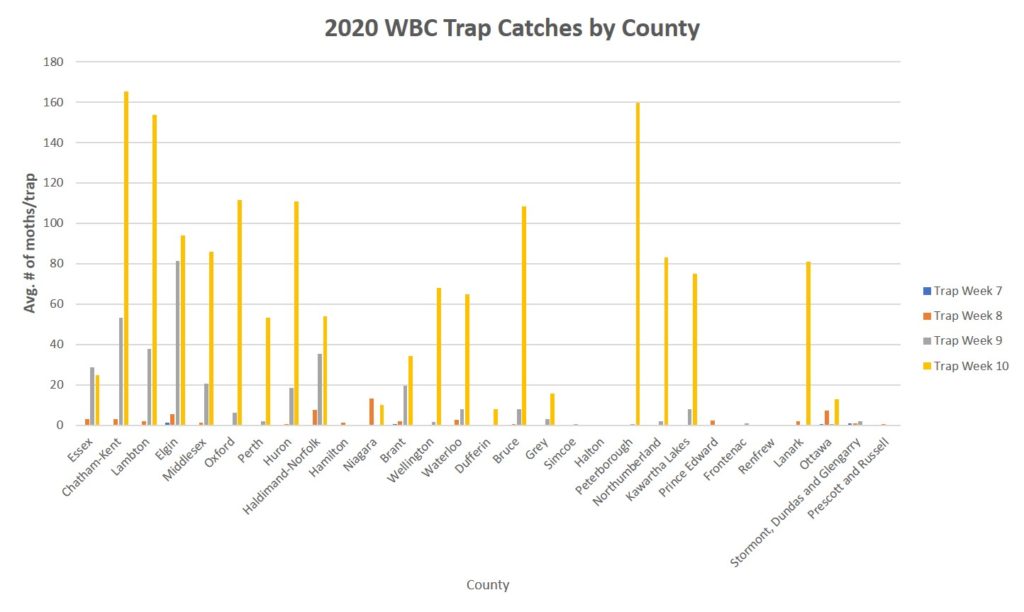Before I talked about the WBC trap data, I want to thank everyone who set up a trap this year and are entering their data into the network. Despite COVID-19, there are more than 1000 WBC traps in the system! That is a record and helps us figure out what the flight patterns are.
Now for the trap results. We are just entering into Week 10 of trapping. Western bean cutworm trap catches have definitely increased over the last few days. The dashboard from the Great Lakes and Maritimes Pest Monitoring Network indicate that the majority of the larger catches are coming from southwestern Ontario though some traps in Bruce and Peterborough counties have also had significant trap catches this week. Highest moth catch in the last 7 days was in Thamesville with 440 moths while one near Aylmer was not far behind at 435 moths. I only have two days of data for this week (Week 10) so I do expect more data to come in the next few days from last week’s monitoring. Expect trap catches could even be higher than that.

What does the data show? We are not at peak flight yet. Michigan seems to also be climbing in catches. Here in Ontario, we have a week or two to go still yet. So even though the corn crop is reaching the right time for a fungicide application for ear mould protection, adding an insecticide now is likely premature. Thankfully, the corn crop did get in earlier than last year. So some of the moths might not choose corn to lay their eggs in (sorry dry bean growers). Or in those areas where most of the corn is at very similar growth stages, there could be a dilution effect, where moths go to several fields in the same area to lay eggs instead of choosing just one or two. Unfortunately, dry beans are very likely going to be equally attractive now that we are in what is typically Week 10 of WBC trapping. We see that already when we compare trap counts by crop. In 2019, peak flight was this week (Week 10) for southern counties while counties in central and eastern Ontario didn’t peak until Week 11 and 12 (next week and two weeks from now).

So what does this all mean. First, make sure they are WBC eggs and not stink bug eggs. Scouts are finding WBC egg masses in many counties. The key is to keep scouting. Remember, even if you find egg masses, they have 5 to 7 days to go before they hatch. Spray timing should aim for when most of the eggs have hatched and larvae are actively feeding on tassels, pollen or headed to the ear. Most of the registered insecticides don’t control eggs. Even if there is some residual activity, it won’t last for the one to two weeks we have to wait for fresh eggs to hatch. It is very likely that more eggs will be laid for another 10 days or more.

When there is an accumulation of 5% of the plants with fresh egg masses or small larvae found over a 2-3 week scouting period, threshold has been reached. Try to time insecticide application as late into full silking stage as possible..close to brown silk, mainly because of the delayed flight and the expectation that more eggs are still to come.
For dry beans, it is best to focus on determining when peak flight has occurred in your field area and focus efforts on scouting for signs of pod feeding and management 10 to 20 days after peak flight. Fields with traps that catch >150 moths are likely more at risk. Spraying too early when pods are not present on the plants will not protect the crop from damage. Spraying too late, when pod feeding has been taking place for some time will not reduce the risk of seed damage and disease incidence. The key is to protect the plants when the larvae are feeding on the young pods.
Comments are closed.